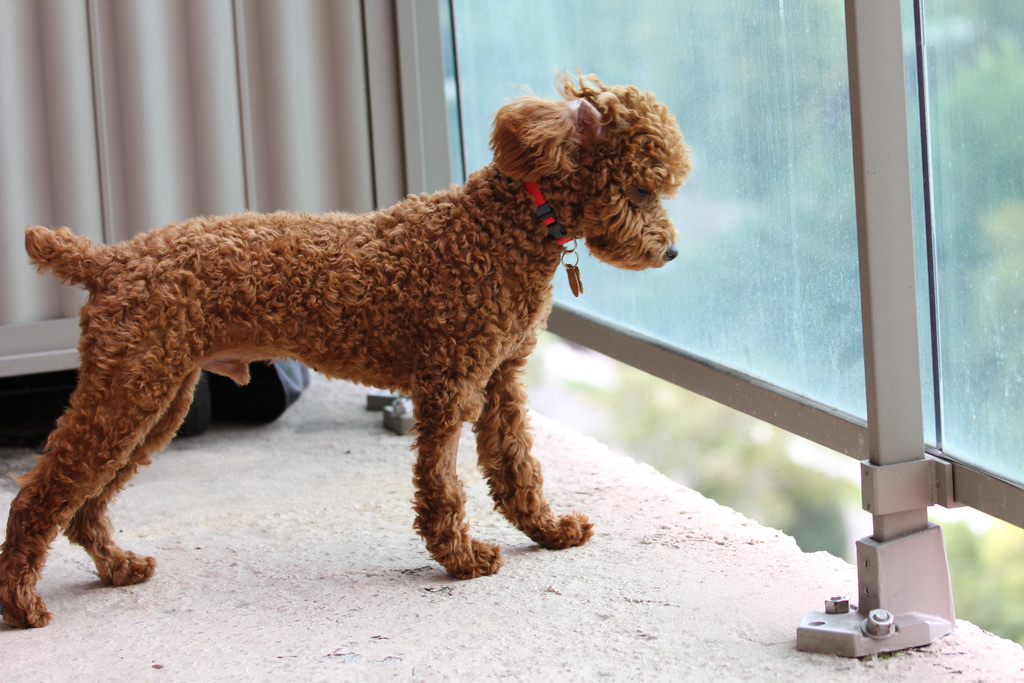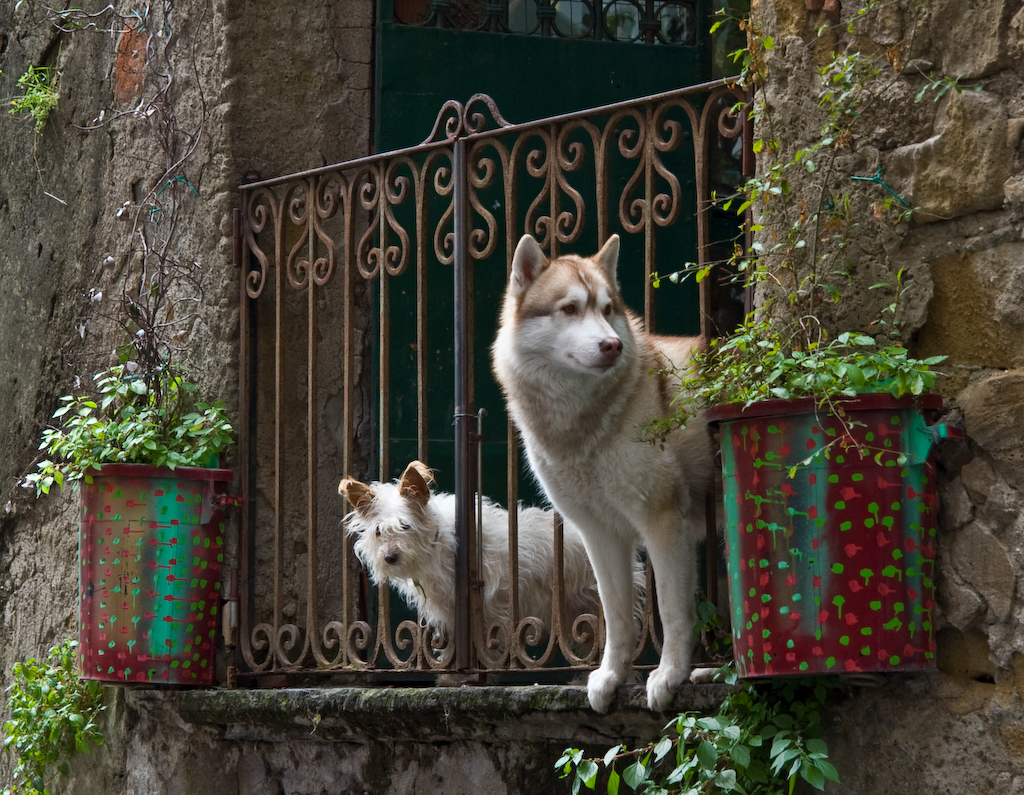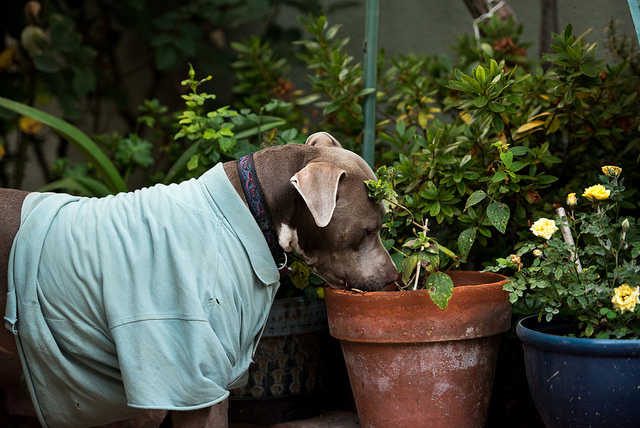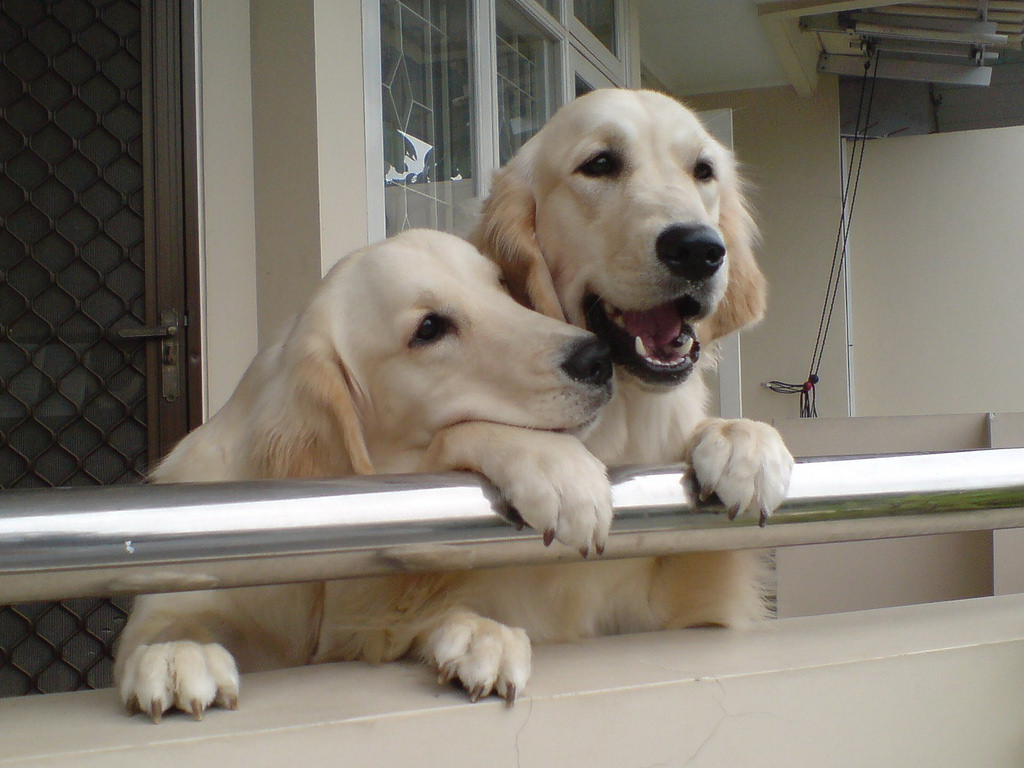7 things you need to do to dog proof your balcony

If you live in the city then you know how important your balcony is when you need a bit of fresh air.
But is it safe for your dog to join you?
It’s no secret that high-rise condos and apartments are the main option for housing in urban areas. This usually means little to no green space. Plus, you don’t have the luxury of opening your back door to a fenced-in yard for your pooch to go explore off-leash.
However, you do have a balcony and pet-proofing it is the next best option.
By dog proofing your balcony you provide them with a place where they can relax in the sun (or shade), take in the fresh air, play in their very own pool and even do their business on a grass pad.
Now, your balcony should never be considered a permanent all-day or night location for a dog; they still need adventurous daily walks and socialization with other dogs. But a properly prepped and setup terrace for your dog to explore can make for great fun.
In this article, we’ll cover the essential things you need to do to dog-proof your balcony. Plus, what plants to keep away from your dog and a helpful outdoor emergency potty solution.
Railing safety
There are different safety precautions to consider when letting your dog out on your balcony, and railing safety is the biggest one.
Condos and apartments have different railing types and numerous floors of housing. Most railings provide the opportunity for any size dog to jump off, get stuck trying to squeeze through or even squeeze through the bars to escape or get hurt.
Eliminate your worry of your pooch seeing a rabbit, another animal or any other distraction and wanting to chase after it. Potential dog-proofing solutions include attaching plexi-panels, heavy-duty porch guard, netting or a screen material to the railing to eliminate any escape routes through the bars. Choose the best solution for your dog’s personality. For instance, if your dog is high energy and likes to chew on any material, a netting might not be the best solution for your balcony. You may want to try lining the railing with a chew-proof fence that is composed of fine chicken wire or plexiglass.
If at anytime you are not comfortable with your dog being on the terrace, then keep them inside. Some dogs and balconies don’t go together, such as a balcony that gets constant wind gusts and a small pup.
Netting or plexiglass can also stop an animal from dropping toys onto a neighbor’s balcony, on parked cars or even into a busy street. This can be dangerous because pets have a tendency to want to run or jump to get the toy they lost.
Dog collar bumpers - an alternative to netting
If netting or plexiglass is not an option for where you live or your pooch is a daredevil, try a puppy bumper. You attach the bumper to your dog’s collar. It has stuffing inside that helps “bump” them back to safety when they try to put their head through the railing. This stuffed collar stops them from fitting through any fence or railing. This may take your canine some time to get use to. You should expect a similar reaction to having a cone on, since it is around their neck .

Collar bumpers can help curious dogs stay safe. Image: Susanne
Remove poisonous plants
Potted plants, herbs and exotic flowers look great on a balcony, but if you’re letting your pooch walk around, you need to make sure they will not get into anything toxic. Some plants and flowers that can harm your pet are:
- Tulips
- Azaleas
- Lilies
- Peonies
- Sago Palm
- Branching and California Ivy
- Iris
- Chinese Evergreen
If you still want flowers or plants on your balcony there are non-toxic alternatives, you can always get a flower box for your railing (if you have a small pup) or hanging baskets (if you have a large pup). Some of the non-toxic options are:
- African Daisy
- African Violet
- Sprouts
- Baby’s Breath
- Basil
- Jasmine
- Japanese Moss
- Pampas Grass
- Pansy Orchid
We go into more detail in our article on the household plants that are dangerous for your dog.
Sprouts are an alternative to grass that you can grow on a balcony. Sprouts are digestible enzymes and minerals canine’s can consume.
The consumption of any plant or flower may cause vomiting and upset your pet’s stomach, so be careful where you put your plants and how many, even if they are non-toxic.
If you’re wondering about other plants or flowers, the ASPCA has an extensive list of toxic and non-toxic plants and a 24-hour Animal Poison Control Center hotline. If you believe that your dog may have ingested a poisonous plant or if you have any questions around toxic plants, you can always contact your local vet.

You don’t want your dog digging into plants that could potentially harm them! Image: Roger Ta
Side note: If you’re interested in starting your own indoor herb garden, then check out our new site Herbs at Home. It has everything you need to know about soil, pruning, lighting, and caring for your indoor herbs and microgreens!
Create a comfort area for your furry friend
You shouldn’t leave your dog on the veranda all day while you’re not home. But there are a few things you can do to create a happy and comfortable environment while you’re around.
Everything is more relaxing with a comfy bed or dog-friendly furniture. Be picky about your pup’s outdoor bed. You will want to make sure it has a machine-washable cover and that it is made of durable waterproof fabric. Don’t forget to check the bed insert! The insert should also be weather resistant, similar to a plastic filling. This will help avoid mold setting in on rainy or snowy days. Natural materials like cotton are more likely to get a mildew smell when they get wet. This is what your pooch will stretch out on when you’re on the balcony together, so you should get a bed with support and that is large enough for them to lay on.
Tip: In the summer or warmer months, you may want to use a raised bed. This allows your pup to get a breeze underneath them and keeps them off the warm concrete or floor.
A dog grass pad is way of experiencing potty time in a hurry. Taking your dog out to exercise and to go potty is more work in an apartment or condo than living in a house with a fenced-in yard. But there are ways to help your puppy go potty without ruining your relationship with your neighbors below you. If you have wooden planks as your flooring on your balcony, safeguard the floor with a mat to help eliminate any accidents.
Taking your dog for a walk to relieve themselves before they have balcony time is always a good idea. If they will be on the deck frequently, getting a grass pad can help. This will allow for your pup to go potty on those busy days when you are running late for work and can’t take your pooch for a routine morning walk. Take a look at what a grass pad is and the different types available.
Provide constant access to water
Whether your dog is indoors or outdoors, always make sure they have plenty of water. Dogs overheat faster than humans, so make sure they can grab a drink whenever they need to. You can disguise the dog bowl on the balcony by putting it into a fun or decorative planter that they can reach. If you place a dog bowl turned into planter in the corner of the balcony, this will make it harder to knock it over.
Another option is a dog water fountain. This is a stylish way to keep them hydrated and keep them distracted for a bit – and can look great on a balcony.
Tip: Make sure that the planter or pot you are using is safe to drink water out of before purchasing. Not all planters are safe for drinking water out of.
Dogs love playing outside on the balcony, especially with a friend! Image: monica renata
Protect against mother nature and outside elements
Depending on where you live, you may get mild winters while other parts of the country get harsh winters. The changes in weather can leave your furry family member shivering.
Different breeds of dogs react to snow and cold weather differently. In the winter season, you don’t want to leave them outside while you are gone. Winter provides unique dangers to dogs, especially if you leave them outside for a prolong period.
One way to keep your canine warm is by having a doggy sweater and a pair of boots on them to help protect their skin and paws. On your veranda, provide an outdoor doghouse or area for them to snuggle into during the summer months. This will give them time to get comfortable with the shelter. They will learn that it’s a safe area to protect them against snow, rain, sun and wind.
When an outdoor shelter is not available for your dog to keep warm, they should be inside when the temperature drops below 40 degrees or when the weather turns for the worst.
Are you living with neighbors above you? The outdoor shelter, which can be anything from an umbrella to a dog house or patio shade, can protect your canine from anything that may fall down from the floors above you. This is something to seriously consider, as you never know what your neighbor may spill or what can fall through onto your balcony.
In contrast, if your dog is outside during the warmer months, overexposure to the sun and heat can dehydrate them. Make sure they have easy access to get indoors and water to help cool them down. Again, shelter is important. This helps your pup get out of the sun when they need to. An umbrella or table can provide them with some protection and shade depending on the sun angle at that time of day.
If your dog has a hard time cooling down or loves lying on a cool tile floor, create a cooling station for them. Including a cooling mat or a mini pool depending on the size of your balcony will provide them hours of cooling relief. Dogs love water and there are plenty of dog foldable pools that you can set up if you plan to spend a warm day on your balcony.
The clean up is easy, as most just require you to drain the water and then fold it up to put the pool away. It’s as easy as 1, 2, 3.
Tip: If you are looking for a stylish way for your pup to stay cool and dry, try a dog tent. There are many different styles and colors available to match their personality or your decor on your balcony.
Store away your chemicals and grill utensils
Keep in mind to store any gardening chemicals and sharp objects like your grill utensils away from your canine. It’s easy to forget when you use these items daily.
Also, remember to keep your canine safe if you’re grilling outdoors to eliminate the risk of them trying to jump up and get a better sniff of the food!
Is it safe to leave your dog on the balcony alone?
Don’t leave your dog on the balcony alone. Some cities have petitions for laws on how long you can keep your canine on the balcony. There are many cases where a dog has either fallen through a bar in the railing or jumped over a railing and injured themselves as a result. If your dog is not getting stimulation, they can get frustrated easily because they are watching other people and dogs walk by below. Their initial reaction is to join the fun.
Never leave your pooch on your balcony unsupervised, even if it’s for a short amount of time, they can still get into trouble. Outdoor balcony time with your furry friend should be supervised and in a controlled environment. Your balcony shouldn’t be used as an alternative to a crate for any reason. It should be used as a playground or palace for when you’re outside enjoying the fresh air with your pup. Install or provide some of the safety precautions we talked about like netting, non-toxic plants, water bowls and a bed.
What about the barking? You’re more than likely to get a noise complaint if you leave your dog outside and they’re barking or whining to come in. This could lead to Animal Control knocking on your door. If they believe the pup is in danger they may choose to rescue them from the balcony.
To wrap up here’s the 7 key things to remember: Railing safety, protection from poisonous plants, always provide water, make the terrace comfortable, give your dog a place to go to the bathroom, protect against the elements, and store away any chemicals and grilling utensils
Remember to treat your pooch like family, provide a puppy play area and have fun with them!
-Candice Crichfield
Candice Crichfield has had the joy of taking care of many pets in her life including her two current family members, a French bulldog and a Boston Terrier-Pug mix aka a Bugg. She owns a home boarding service and over the past decade taking care of animals has become her passion.
Feature image: Andy Chow

